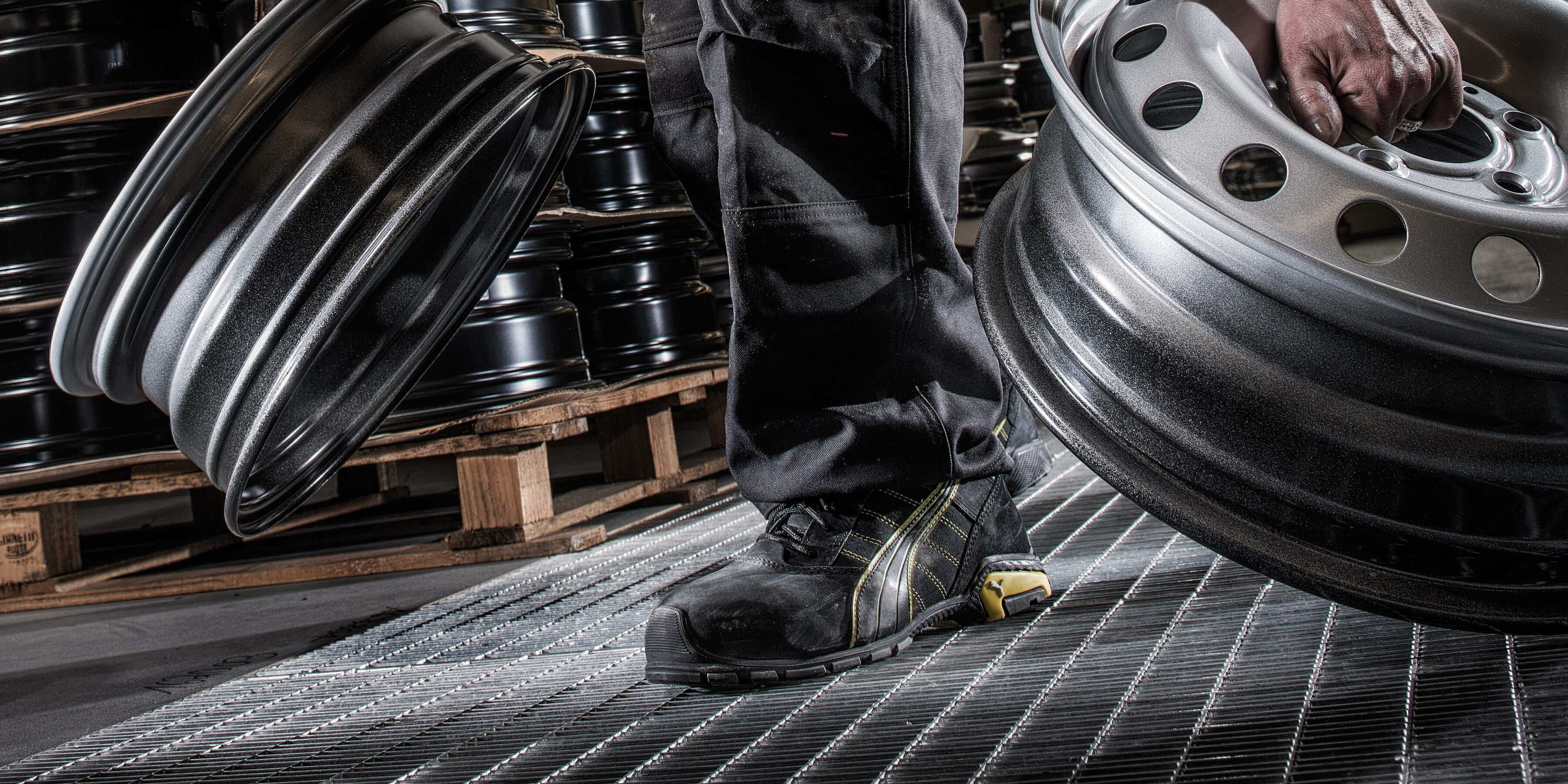What is safety footwear used for?
Certain jobs expose the feet to risks, quite a lot of jobs actually. Whenever this is the case, it’s important to wear suitable footwear that adequately protects the user.
According to statistics from the HSE, slips, trips or falls on the same level were the most common reported non-fatal accident kind across all broad industry sectors in 2020/21. Although slips, trips and falls are not the only danger at work. There are a large number of other common foot-related accidents, including:
- Impacts from heavy objects, resulting in crushing injuries.
- Perforations and cuts.
- Absorption of liquids, such as water, oil or chemicals.
- Static electricity build-up and its consequences.
- Damage caused by extreme temperatures.
:quality(60)/1f8f22d9-b715-495a-8156-62cf561d84d8/20450842-3a44-46ac-83cd-9da44de14ece.jpg)
Types of safety footwear
It’s important to note that the term "safety footwear" as a way of referring to the entire group of footwear for professional use is, in fact, incorrect. At the regulatory level, it’s considered a type or category of professional footwear .
Safety footwear or any other type of footwear for professional use must be chosen based on an analysis of the risks of each sector, depending on the work environment and the tasks the user is involved in.
Footwear for professional use is subject to various tests to determine its level of protection. They are split into three categories:
- Safety footwear (EN ISO 20345)
- Protective footwear (EN ISO 20346)
- Occupational footwear (EN ISO 20347)
As well as the standards applicable to each of the above, they are also categorised as personal protective equipment (PPE).
:quality(60)/1f8f22d9-b715-495a-8156-62cf561d84d8/76134760-552a-4184-ae31-610e9e77daac.jpg)
Occupational footwear (O)
EN ISO 20347
This standard covers the basic requirements that occupational footwear must conform with for professional use. Occupation footwear is not equipped with a toe cap and it does not guarantee protection against impacts and compression to the forefoot.
The letter "O" is used for occupation footwear. As with the other types of professional footwear, safety ratings and abbreviations (or codes) are used to identify the degree of protection and to describe the features and characteristics of the footwear.
:quality(60)/1f8f22d9-b715-495a-8156-62cf561d84d8/60a9c63c-c7d8-4ab6-bc4f-b11e169dbc56.png)
Protective footwear (P)
EN ISO 20346
Includes the basic requirements of the occupational footwear standard and is equipped with a toe cap to protect against impacts with an energy level of at least 100 Joules (J). This footwear protects the toe from damage by compressions or being crushed under heavy objects of at least 10 Kilonewtons (kN). The code for protective footwear is "P".
:quality(60)/1f8f22d9-b715-495a-8156-62cf561d84d8/83e4e108-6def-431d-81e1-dbab87ea9fca.png)
Safety Footwear (S)
EN ISO 20345
Safety boots or safety shoes typically provide maximum protection against accidents, including mechanical hazards as well as slip resistance and protection against thermal hazards. They are also normally better in terms of ergonomics.
This type of footwear is equipped with a toe cap to protect against impacts with an energy level of at least 200 J. It also protects the toe from damage caused by falling objects and crushing or compression damage of at least 15 kN. The letter "S" is used for safety footwear.
:quality(60)/1f8f22d9-b715-495a-8156-62cf561d84d8/76e8212d-e471-47a3-83a8-6df1f7ab89e1.png)
Slip-resistant footwear
The above standards do not include slip-resistant footwear as an individual or standalone category, but rather as a characteristic that each of the above types of footwear can possess.
Regardless of industry, slip-resistant soles are extremely important. It’s one of the most accident-preventing features when it comes to professional footwear. Always take the level of slip-resistance into consideration when choosing footwear for work. There are three requirements used to mark a shoe as slip-resistant:
- SRA: Tested on ceramic tile floors with water and a diluted soap solution.
- SRB: Tested on stainless steel floors with glycerol as a lubricant.
- SRC: Tested on both ceramic tiles and stainless steel floors under SRA and SRB conditions. This offers the most resistance.
:quality(60)/1f8f22d9-b715-495a-8156-62cf561d84d8/88e8fa37-4758-444f-8f85-2090bb4fa716.jpg)
Other potential requirements
Outsole: Fuel/oil resistant outsole (FO), Energy absorption in the heel (E), Contact heat resistance up to 300°C for 60 seconds (HRO), Insulation against heat (HI) or cold (CI).
Material and structure: Midsole penetration resistance (P), Antistatic protection (A), Water penetration and absorption resistant upper (WRU), Cut-resistant upper (CR), Metatarsal protection (M), Ankle protection (AN), Electro-static discharge (ESD).
Markings and declarations of conformity
All safety, protective or occupational footwear must be certified and clearly show that it conforms to safety standards. Footwear should also carry the following information:
- Size
- Manufacturers identification mark
- Model name or reference
- Year and the quarter of manufacture
- The pictograms or symbols with the protection offered
- Number of the standard
- CE or UKCA marking
:quality(60)/1f8f22d9-b715-495a-8156-62cf561d84d8/9c150d6d-d1fd-49c6-ad60-70243516ed54.jpg)
Protection aside, never forget the importance of comfort, which is pivotal for workers who spend many hours walking or standing.
We must always be conscious that PPE is the last barrier of defence when risks cannot be eliminated or controlled by other means.
Every worker must be trained and informed about why and how to use safety footwear. Following a series of safety protocols and measures to monitor and evaluate the use of PPE in the workplace on an ongoing basis is crucial.
Safeguru | Delivering a Safer Future
